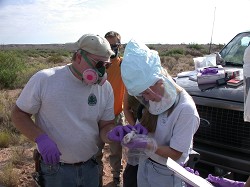
Dr. Greg Glass
Professor Emeritus
Focus Areas
Areas of Specialization
- Medical Geography
- Risk factor analysis
- Vector-borne and Zoonotic Diseases
Educational Background
- Post-Doctoral Fellow in Immunology & Infectious Diseases, Johns Hopkins University, 1986
- PhD in Systematics & Ecology, University of Kansas, 1983
- MPhil in Systematics & Ecology, University of Kansas, 1981
- M.A. in Systematics & Ecology, University of Kansas, 1979
- B.A. in Biology, Boston University, 1974
Recent Courses
- Advanced Research Methods in Medical Geography & Spatial Epidemiology
- Public Health Ecology
- GIS & Spatial Statistics
- Vector borne Diseases
Students Recently Graduated
- Nicholas Dowhaniuk – World Health Organization
- Dr. Abolfazl Mollalo – Assistant Professor, Baldwin Wallace University
- Dr. Ubydul Haque – Assistant Professor, University of North Texas Science Center
- Dr. Barbara Ellis – Deputy Director, Public Health Preparedness, CDC
- Dr. Erik Hofmeister – Research Virologist, National Wildlife Health Center, USGS
- Dr. Martin Sanders – Chief, Public Health, Safety, and Preparedness, US DHS
- Dr. William Nicholson – Branch Chief, Viral & Rickettsial Zoonoses Branch, CDC
- Dr. Brian Bird – Director, One Health Institute, UC Davis School of Veterinary Medicine
- Dr. Sabra Klein – Professor, Molecular Microbiology & Immunology, Johns Hopkins University
- Dr. Scott Shone – Director, North Carolina State Laboratory of Public Health
In My Own Words
My lab focuses on understanding the bases of infectious disease systems; the agents, hosts, and environmental sources. We are especially interested in characterizing how changes in environmental conditions over space and time alter the patterns of disease that we see. These patterns often provide key clues to identify what triggers disease emergence/outbreaks and may give us clues for intervention and prevention. In a broader sense, we use this information to assess how well regional and national health care programs work to improve the health of people and animals. We combine data from numerous sources, including remotely sensed imagery with epidemiologic studies in statistical analyses. Our goal is to use geospatial science to find ways to anticipate and intervene to prevent large-scale disease outbreaks before they happen.
Recent Publications
Ebi, K.L., J.M. Balbus, G. Luber, A. Bole, A. Crimmins, G. Glass, S. Saha, M.M. Shimamoto, J. Trtanj, and J.L. White-Newsome, 2018: Human Health. In Impacts, Risks, and Adaptation in the United States: Fourth National Climate Assessment, Volume II [Reidmiller, D.R., C.W. Avery, D.R. Easterling, K.E. Kunkel, K.L.M. Lewis, T.K. Maycock, and B.C. Stewart (eds.)]. U.S. Global Change Research Program, Washington, DC, USA, pp. 572–603. doi: 10.7930/NCA4.2018.CH14
Childs, JE, SL Klein GE Glass. 2019. A case study of two rodent-borne viruses: Not the usual suspects. Frontiers in Ecology and Evolution 7: 35 doi: 10.3389/fevo.2019.00035.
Mollalo, A. L. Mao, P. Rashidi, GE Glass. 2019. A GIS-based Artificial Neural Network model for spatial distribution of Tuberculosis across the continental United States. International Journal of Environmental Research and Public Health 16, 157; doi:10.3390/ijerph16010157.
Haque, U, da Silva, PF, Devoli, G, Pilz, J, Zhao, B, Khaloua, A, Wilopo, W, Andersen, P, Ping, L, Lee, P, Yamamoto, T, Keelling, D, Wu, J, Glass, GE. 2019. The human cost of global warming: Deadly landslides and their triggers (1995-2014). Science Total Env 682, 673-684. doi:10.1016/j.scitotenv.2019.03.415
Kessler, WH, C Ganser, GE Glass. 2019. Modeling the distribution of medically important ticks in Florida. Insects 10 (7): 190. doi:10.3390/insects10070190
Demchyshyna, IV, GE Glass, OA Hluzd, VV Kutseva, MK Taylor, EP Williams, V Kurpita, CB Jonsson. 2020. Cocirculation of two Orthohantavirus species in small mammals of Northwestern Ukraine. J Wildlf Dis 56: doi: 10.7589/2019-09-238
Kortessis, N., MW Simon, M Barfield, G Glass, BH Singer, RD Holt. 2020. The interplay of movement and spatiotemporal variation in transmission degrades pandemic control. Proc Natl Acad Sci. doi: 10.1073/pnas.2018286117.
Glass, GE, C Ganser, WH Kessler. 2021. Validating species distribution models using standardized surveys for ixodid ticks in mainland Florida. J Med Entomol. doi: 10.1093/jme/tjaa282
Williams, E, MK Taylor, I Demchyshyna, I Nebogotkin, O Nesterova, I Khuda, L Chernenko, OA Hluzd, VV Kutseva,GE Glass, N Yanko, CB Jonsson. 2021. Prevalence of hantaviruses harbored by murid rodents in Northwestern Ukraine and discovery of a novel Puumala virus isolate. Viruses 13:1640. doi: 10.3390/v13081640
Parmenter, RR, GE Glass. 2022. Hantavirus outbreaks in the American Southwest: Propagation and retraction of rodent and virus diffusion waves from sky island refugia. Int J Mod Physics B 2140052 doi: 10.1142/S021797922140052X
Kessler, WH, C DeJesus, SM Wisely, GE Glass. 2022. Ensemble models for tick vectors: standard surveys compared with convenience samples. Diseases 10: 32. doi: 10.3390/diseases10020032
Shannon, KL, T Shields, S Ahmed, H Rahman, CS Prue, J Khyang, M Ram, MZ Haq, J Akter, GE Glass, MM Nyunt,DA Sack, DJ Sullivan Jr., WA Khan, FC Curriero. 2022. Temporal and spatial differences between sub-clinical and clinical malaria infections in the Chittagong Hill Districts, Bangladesh. Am J Trop Med Hyg doi: 10.4269/ajtmh.21-0121.
Schaper, T, R Khatami, MM Hassan, GE Glass, J Southworth. 2022. Monitoring major crop change trends in [sic] Agricultural in Florida. Am J GIS 11:23-31. doi: 10.5923/j.ajgis.20221101.03
Recent Research Grants
2016-2019 NIOSH Extent of agricultural pesticide application in Florida using best practices
2017-2021 CDC Southeast regional center of excellence in Vector borne diseases (VBD) Gateway CoE
2017-2022 NSF The future of U.S. forest function under changing environment, disturbance and forest management
2010-2016 NIH 1U19AI089680-01
Malaria Transmission and the Impact of Control Efforts in Southern Africa
2011-2016 NIH U54 HD070725-01
Johns Hopkins Global Center on Childhood Obesity
2012-2015 SRI subcontract
Mapping especially dangerous pathogens in the Ukraine.
2010-2015 NIH T32 AI007417
Training in Molecular and Cellular Bases of Infectious Disease
2010-2015 NSF 0955897
EcoHealthNet: Ecology, environmental science and health research network
2009-2014 Bill and Melinda Gates Foundation Global Health
Predicting dengue epidemics with entomological and virological surveillance by xenomonitoring

